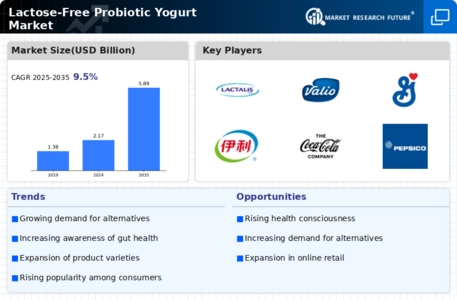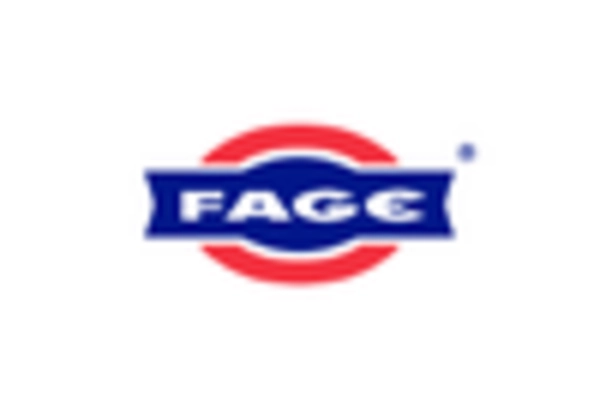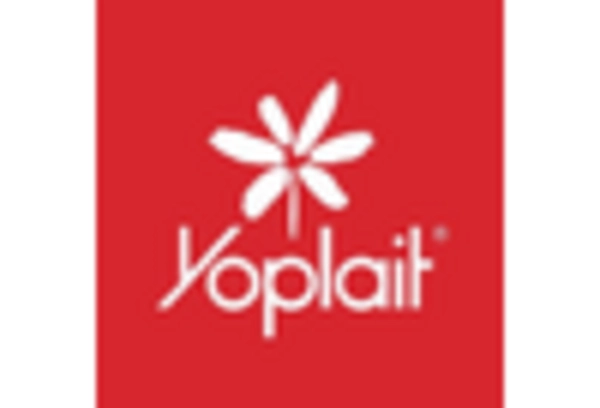Rising Lactose Intolerance
The Lactose-Free Probiotic Yogurt Market is significantly influenced by the rising prevalence of lactose intolerance among various populations. Studies indicate that a substantial portion of the global population experiences some degree of lactose intolerance, leading to a growing demand for lactose-free alternatives. This condition often results in discomfort when consuming traditional dairy products, prompting consumers to seek lactose-free options. The market for lactose-free products, including yogurt, is expected to expand as more individuals become aware of their dietary restrictions. The Lactose-Free Probiotic Yogurt Market is thus likely to benefit from this trend, as it provides a viable solution for those who wish to enjoy yogurt without the adverse effects associated with lactose.
Innovative Product Offerings
Innovation plays a crucial role in the Lactose-Free Probiotic Yogurt Market, as manufacturers continuously develop new flavors, textures, and formulations to attract consumers. The introduction of unique ingredients, such as plant-based alternatives and added nutrients, has broadened the appeal of lactose-free probiotic yogurt. Recent market analysis suggests that product diversification is a key driver of growth, with consumers increasingly seeking novel and exciting options. This trend is reflected in the rising number of new product launches, which cater to various dietary preferences and lifestyles. As the Lactose-Free Probiotic Yogurt Market evolves, innovation will remain a pivotal factor in capturing consumer interest and expanding market share.
Health Benefits of Probiotics
The Lactose-Free Probiotic Yogurt Market is experiencing a surge in demand due to the increasing awareness of the health benefits associated with probiotics. Probiotics are known to enhance gut health, improve digestion, and boost the immune system. As consumers become more health-conscious, they are actively seeking products that offer these benefits. According to recent data, the probiotic yogurt segment is projected to grow at a compound annual growth rate of approximately 7% over the next five years. This growth is indicative of a broader trend where consumers prioritize functional foods that contribute to overall well-being. The Lactose-Free Probiotic Yogurt Market is well-positioned to capitalize on this trend, as it caters to individuals with lactose intolerance while providing the added advantages of probiotics.
Increased Availability in Retail Channels
The accessibility of lactose-free probiotic yogurt has improved significantly, contributing to the growth of the Lactose-Free Probiotic Yogurt Market. Retailers are increasingly stocking a variety of lactose-free products, making it easier for consumers to find and purchase these items. The expansion of distribution channels, including online platforms and specialty health food stores, has further enhanced availability. Recent statistics indicate that sales of lactose-free products have risen sharply, with many consumers now considering these options as staples in their diets. This increased availability not only meets consumer demand but also encourages trial and repeat purchases, thereby driving growth in the Lactose-Free Probiotic Yogurt Market.
Consumer Preference for Natural Ingredients
There is a growing consumer preference for natural and organic ingredients, which is significantly impacting the Lactose-Free Probiotic Yogurt Market. As consumers become more discerning about their food choices, they are increasingly seeking products that are free from artificial additives and preservatives. This trend aligns with the broader movement towards clean label products, where transparency in ingredient sourcing is paramount. Market Research Future indicates that products labeled as organic or containing natural ingredients are more likely to attract health-conscious consumers. Consequently, the Lactose-Free Probiotic Yogurt Market is adapting to these preferences by emphasizing the use of high-quality, natural ingredients in their offerings, thereby enhancing their appeal to a wider audience.


















Leave a Comment